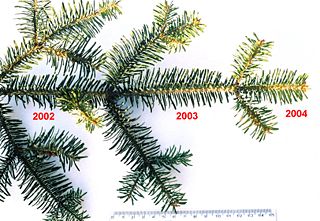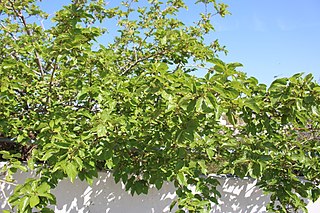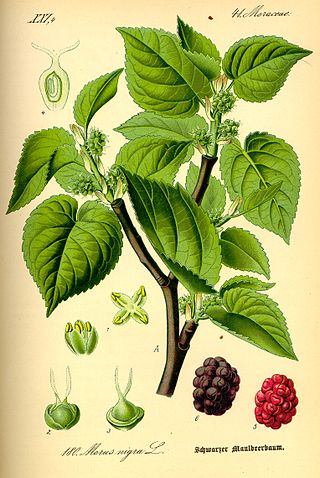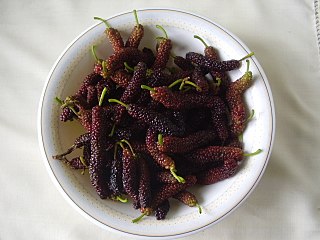
The Moraceae — often called the mulberry family or fig family — are a family of flowering plants comprising about 38 genera and over 1100 species. Most are widespread in tropical and subtropical regions, less so in temperate climates; however, their distribution is cosmopolitan overall. The only synapomorphy within the Moraceae is presence of laticifers and milky sap in all parenchymatous tissues, but generally useful field characters include two carpels sometimes with one reduced, compound inconspicuous flowers, and compound fruits. The family includes well-known plants such as the fig, banyan, breadfruit, jackfruit, mulberry, and Osage orange. The 'flowers' of Moraceae are often pseudanthia.

In botany, an evergreen is a plant which has foliage that remains green and functional through more than one growing season. This contrasts with deciduous plants, which completely lose their foliage during the winter or dry season.

In the fields of horticulture and botany, the term deciduous means "falling off at maturity" and "tending to fall off", in reference to trees and shrubs that seasonally shed leaves, usually in the autumn; to the shedding of petals, after flowering; and to the shedding of ripe fruit. The antonym of deciduous in the botanical sense is evergreen.

The sycamine tree is a tree mentioned in both classical Hebrew literature and in Greek literature. The tree is also known by the names sycamore fig tree, and fig-mulberry. It appears also in Luke 17:6 and 19:4 of the Bible. The Hebrew word for the tree is shiḳmah (sing.), shiḳmīn (pl.), having nearly the same phonemes in Greek Others, however, identify the tree as mulberry tree, found in two species, the black mulberry and the white mulberry, which are common in Palestine. It is in the same family as the fig-tree.
The bricks are fallen, but we will build with hewn stones; the sycamores are cut down, but cedars will we put in their place.

Morus, a genus of flowering plants in the family Moraceae, consists of diverse species of deciduous trees commonly known as mulberries, growing wild and under cultivation in many temperate world regions. Generally, the genus has 64 subordinate taxa, three of which are well-known and are ostensibly named for the fruit color of the best-known cultivar: white, red, and black mulberry, with numerous cultivars and some taxa currently unchecked and awaiting taxonomic scrutiny. M. alba is native to South Asia, but is widely distributed across Europe, Southern Africa, South America, and North America. M. alba is also the species most preferred by the silkworm, and is regarded as an invasive species in Brazil and the United States.

The tropical and subtropical dry broadleaf forest is a habitat type defined by the World Wide Fund for Nature and is located at tropical and subtropical latitudes. Though these forests occur in climates that are warm year-round, and may receive several hundred centimeters of rain per year, they have long dry seasons that last several months and vary with geographic location. These seasonal droughts have great impact on all living things in the forest.

Gannets are seabirds comprising the genus Morus in the family Sulidae, closely related to boobies.

Morus alba, known as white mulberry, common mulberry and silkworm mulberry, is a fast-growing, small to medium-sized mulberry tree which grows to 10–20 m (33–66 ft) tall. It is generally a short-lived tree with a lifespan comparable to that of humans, although there are some specimens known to be more than 250 years old. The species is native to China and India and is widely cultivated and naturalized elsewhere.

Maclura tricuspidata is a tree native to East Asia, occasionally grown for its fruit, somewhat similar to that of the related mulberry. It is also known by common names including cudrang, kujibbong, storehousebush, mandarin melon berry, silkworm thorn, zhe or che, and Chinese mulberry. It grows up to 6 m high.

Morus rubra, commonly known as the red mulberry, is a species of mulberry native to eastern and central North America. It is found from Ontario, Minnesota, and Vermont south to southern Florida, and west as far as southeastern South Dakota, Nebraska, Kansas, and central Texas. There have been reports of isolated populations in New Mexico, Idaho, and British Columbia.
Moru is an ethnic group of South Sudan. Most of them live in Western Equatoria. They speak Moru, a Central South Sudanic language. Many members of this ethnicity are Christians, most being members of the Episcopal Church of the South Sudan (ECS). The Pioneer missionary in the area was Dr Kenneth Grant Fraser of the Church Missionary Society (CMS). The population of this ethnicity possibly does not exceed 200,000.
Morus serrata, known as Himalayan mulberry, is a species of mulberry native to the Himalaya and the mountains of southwestern China, at altitudes of up to 2,300 metres.

Morus nigra, called black mulberry, is a species of flowering plant in the family Moraceae that is native to southwestern Asia, where it has been cultivated for so long that its precise natural range is unknown. The black mulberry is known for its large number of chromosomes.

Temperate deciduous or temperate broad-leaf forests are a variety of temperate forest 'dominated' by deciduous trees that lose their leaves each winter. They represent one of Earth's major biomes, making up 9.69% of global land area. These forests are found in areas with distinct seasonal variation that ranges from warm, moist summers to cool winters. The six major areas of this forest type occur in the Northern Hemisphere: North America, East Asia, Central and Western Europe, northern Spain, Denmark, southern Sweden, southern Norway and in the southern hemisphere in Patagonia. Examples of typical trees in the Northern Hemisphere's deciduous forests include oak, maple, basswood, beech and elm, while in the Southern Hemisphere, trees of the genus Nothofagus dominate this type of forest.

Morus celtidifolia, the Texas mulberry, is a plant species native to South America, Central America, Mexico, and the southwestern United States, ranging from Argentina north as far as Arizona and Oklahoma. In the US, it grows in canyons and on slopes, usually near streams, from 200–2,200 metres in elevation. It is very often referred to as "Morus microphylla," including in Flora of North America, but recent studies suggest that these names are synonymous with M. celtidifolia holding priority.

Morus macroura, also known as the king white mulberry, shahtoot mulberry, Tibetan mulberry, or long mulberry is a flowering plant species in the genus Morus found in Tibet, the Himalayas, mountainous area of Indonesia, and rain forests of Indochina. It is a medium-sized tree, with a spreading canopy which grows with a weeping habit. Ripe fruit is white, pink or red, and is described as honey-sweet.

The Mulberry garden, originally Morušová zahrada in Czech, is a cottage garden in the Czech Republic, situated in the Czech Central Uplands in the village Režný Újezd, 7 kilometres (4.3 mi) northwest of the town Lovosice. The garden was established in 2014 by local gardeners admiring the English cottage garden style. Apart from different kinds of plants such as perennial plants, English historical roses, Czech roses, annual plants, and bulbs, several uncommon fruit trees are grown, especially various mulberry varieties. Mulberry garden is located along the green tourist track to Boreč hill in the grounds of former Gentlemen's farm, house no. 2.

Morus indica is a member of the genus Morus, of the family of flowering plants Moraceae, commonly known as the mulberry family. As with other mulberries, Morus indica is a deciduous tree. Morus indica is native to the temperate and sub-tropical Himalayan region. It is currently cultivated in India, China, Japan, and East Africa.















